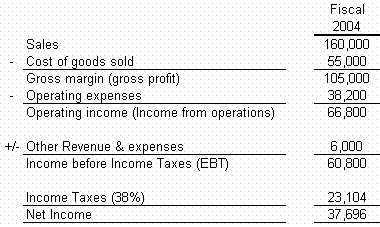Published On:Friday, 23 December 2011
Posted by Muhammad Atif Saeed
Income Statement Basics
Within this basics section, we will define each component of a multi-step income statement, and prepare a multi-step income statement.
Multi-Step Income Statement
A multi-step income statement is a condensed statement of income as opposed to a single-step format, which is the more detailed format. Both single and multi-step formats conform to GAAP standards. Both yield the same net income figure.
The main difference is how they are formatted, not how figures are calculated.
Figure 6.3: Multi-Step Income Statement
Multi-Step Income Statement
A multi-step income statement is a condensed statement of income as opposed to a single-step format, which is the more detailed format. Both single and multi-step formats conform to GAAP standards. Both yield the same net income figure.
The main difference is how they are formatted, not how figures are calculated.
Figure 6.3: Multi-Step Income Statement
 |
- Sales - These are defined as total sales (revenues) during the accounting period. Remember these sales are net of returns, allowances and discounts
- Cost of goods sold (COGS) - These are all the direct costs related to the product or rendered service sold and recorded during the accounting period. (Reminder: matching principle.)
- Operating expenses - These include all other expenses that are not included in COGS but are related to the operation of the business during the specified accounting period. This account is most commonly referred to as "SG&A" (sales general and administrative) and includes expenses such as selling, marketing, administrative salaries, sales salaries, maintenance, administrative office expenses (rent, computers, accounting fees, legal fees), research and development (R&D), depreciation and amortization, etc.
- Other revenues & expenses - These are all non-operating expenses such as interest earned on cash or interest paid on loans.
- Income taxes - This account is a provision for income taxes for reporting purposes.
About the Author
Posted by Muhammad Atif Saeed on 19:36. Filed under Accounting, feature . You can follow any responses to this entry through the RSS 2.0. Feel free to leave a response









